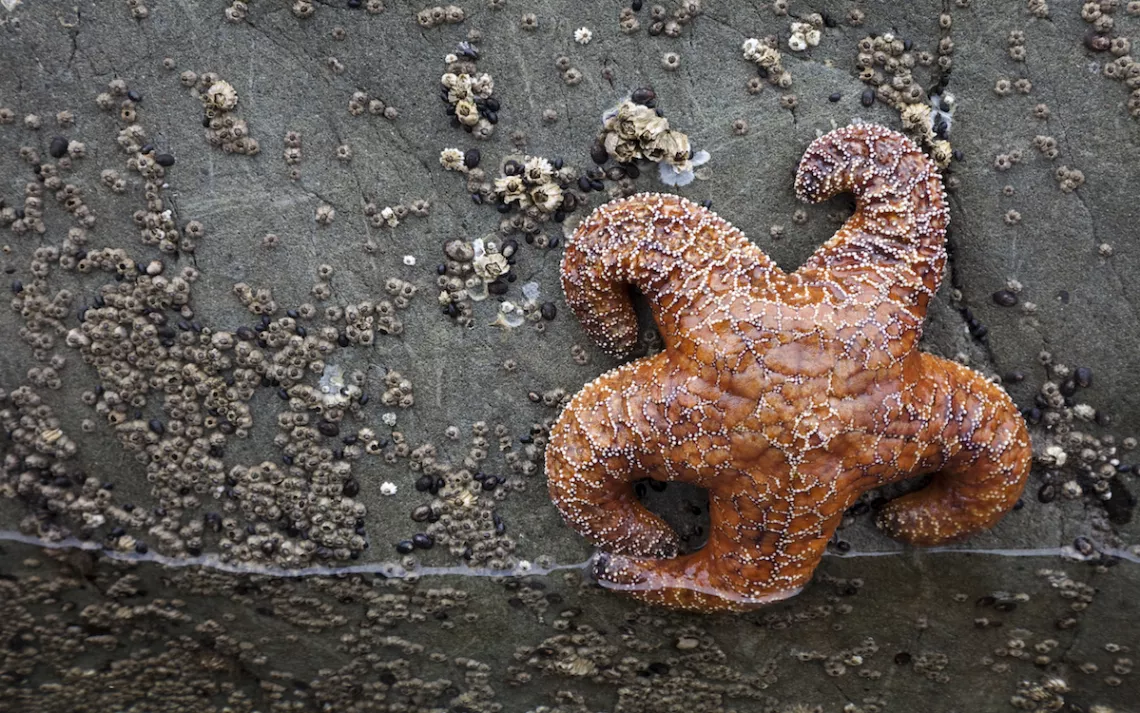Left for Dead, Starfish Bounce Back
Genetic resilience in the face of astronomical die-off

Photo by mddphoto/iStock
Five years ago, Pacific Coast sea stars appeared to be goners, as a mysterious disease ravaged up to 80 percent of their population. “The disease is called sea star wasting disease,” says Melissa Miner, a research scientist employed by UC Santa Cruz but based in Bellingham, Washington. “But it’s really not wasting that’s happening. That implies a slow process. For most of these animals, they get sick, and it’s fast.”
The course of the disease was ugly: Lesions formed on the bodies of sea stars of dozens of different species from Baja California to the Alaska panhandle. Limbs detached. The rest of the body melted away. One of those species, the orange and purple starfish known as the ochre star, or Pisaster ochraceus, died off in astronomical numbers. At one of her monitoring sites on Bellingham Bay, Miner estimated that over 90 percent of ochre stars died, seemingly overnight. “This was a place where we usually had hundreds and hundreds of ochre stars,” she says. “It was like a switch had been flipped. Everything was dying. There were sea star carcasses all over the intertidal.”
Today, the ochre star is coming back. Not everywhere, reminds Miner—she has yet to see them in significant numbers in her home bay in Bellingham, for example. But citizen-scientist observation logs and the consortium of research groups she works with called the Multi-Agency Rocky Intertidal Network, or MARINe, have noted successful recruitment of juvenile sea stars in many areas between Oregon and central California.
The reason for the ochre sea star’s survival and eventual recovery, scientists say, relies on its ability to change its genetics, to rapidly evolve.
“We look at Pisaster, and their future is hopeful,” says Lauren Schiebelhut, a postdoc at UC Merced. Her research published earlier this year in Proceedings of the National Academy of Sciences found a genetic resistance in the surviving population of ochre stars that could lead to recovery across its range.
Schiebelhut had studied Pisaster ochraceussince before its spectacular meltdown. It’s a keystone species and one of the only predators on the mussels that otherwise monopolize the intertidal zone. Not only is the ochre star a keystone predator, it’s the keystone species: The relationship between ochre stars and their ecosystem was the focus of Robert Paine’s landmark study establishing the keystone concept in modern ecology.
When the outbreak hit, Schiebelhut—a graduate student at the time—had already collected tissue samples of ochre stars to study its genetic code. Her dissertation focused on marine mass mortality events, like algal blooms. And so the outbreak of wasting disease—the largest marine mass mortality event to date—presented a rare opportunity. “I just happened to be in the right place at the right time,” she says.
Since she had already collected genetic material pre-outbreak, she was able to look at the genetics between the original population and the surviving stars. And she noticed a genetic shift. “That same shift was seen at multiple locations along the coast, and in the new juvenile recruits,” she says. “Which points to natural selection, or microevolution.”
This is not the only case of rapid genetic adaptation to climate change or other extreme shifts in their ecosystem. Snail kites in Florida developed larger bills to forage larger snails that had invaded their habitat. Anole lizards have evolved larger toe pads to climb higher in trees to escape an invasion of competing lizards.
“There’s been more and more of these cases of species showing that [these species] have the standing genetic variation to help them respond to these changes,” says Schiebelhut.
With sea stars, we still don’t know exactly why they are able to micro-evolve while other keystone starfish like the sunflower star have a bleaker outlook. The cause for the wasting disease outbreak is still largely unknown. Shortly after the outbreak, Ian Hewson, an oceanographer at Cornell, pointed at a particular densovirus for causing the disease. But just six months ago, he walked that back, reporting that a pathogen could still be involved, though other environmental stressors like warming ocean temperatures and acidification might also be at play. “At this point there’s just a lot more questions then there are answers,” Miner says.
Miner sees a silver lining in the episode: By almost losing starfish, many people realized how much they value them. “People have a strong emotional connection with this species," she says. "It’s just so visually representative of the coast. They’re about as charismatic a species as you can be if you’re an invertebrate.”
 The Magazine of The Sierra Club
The Magazine of The Sierra Club



